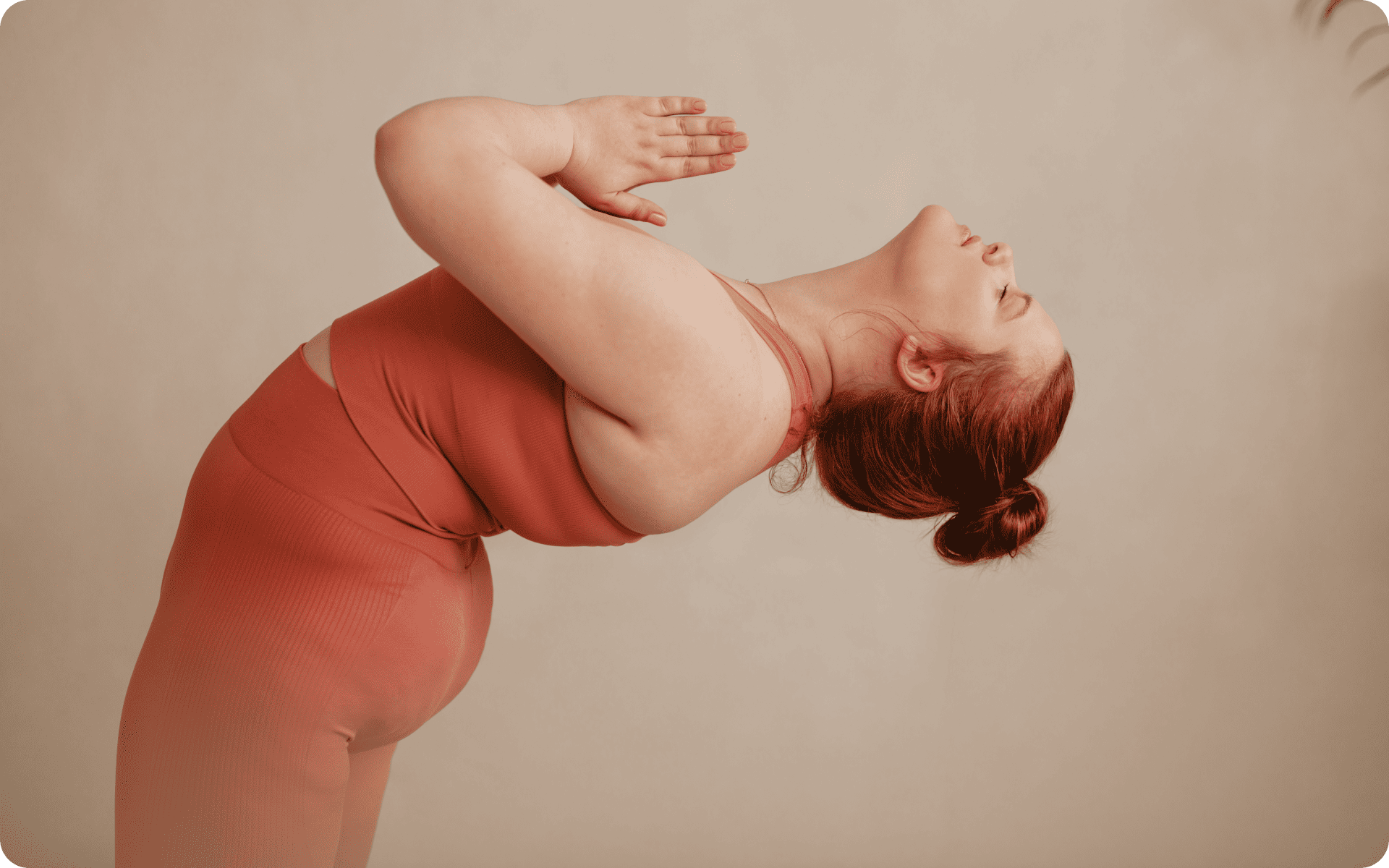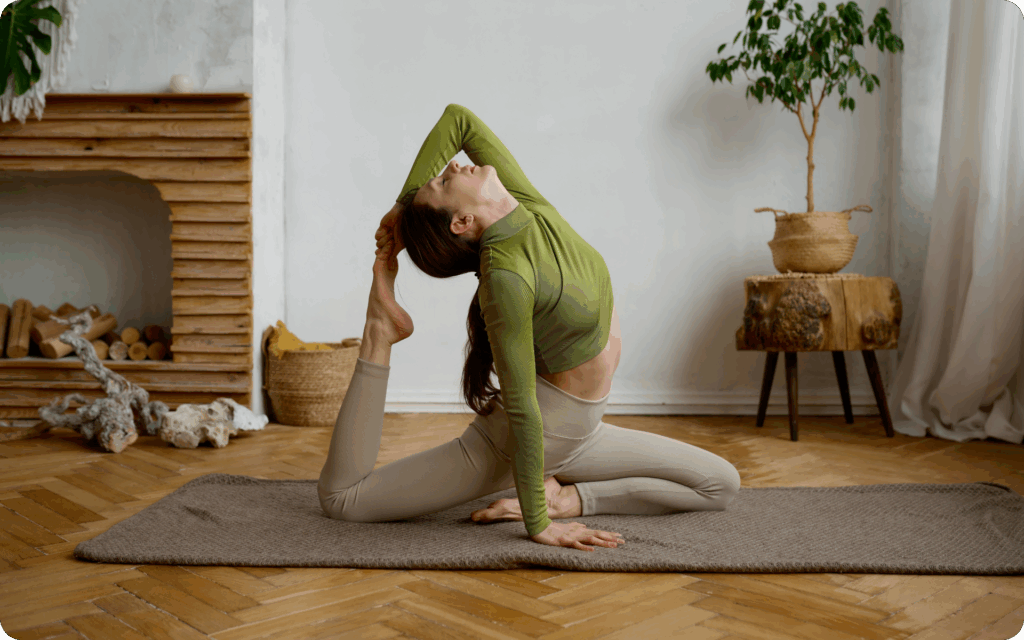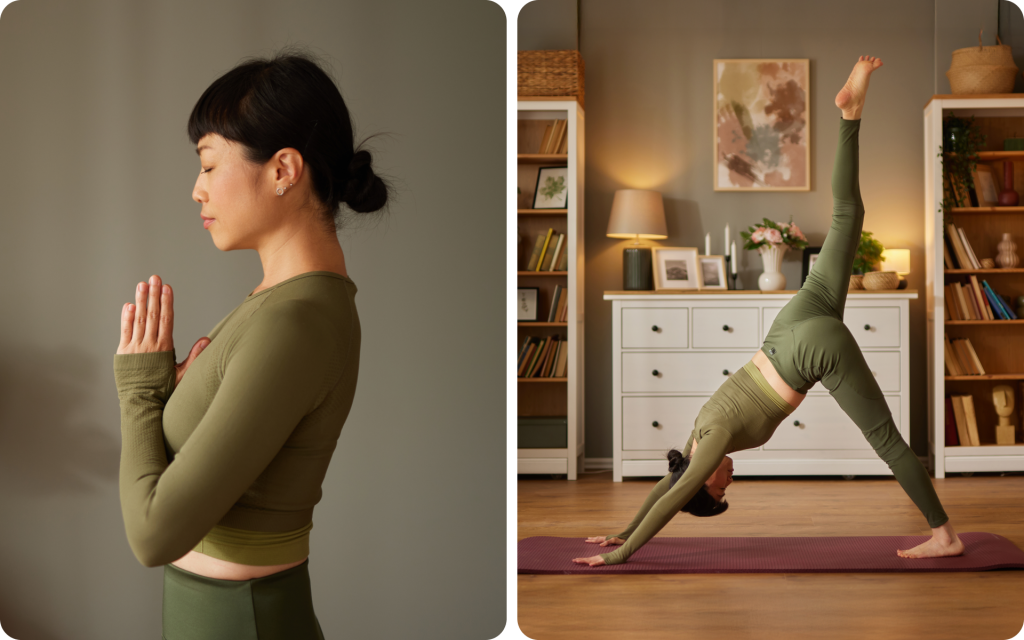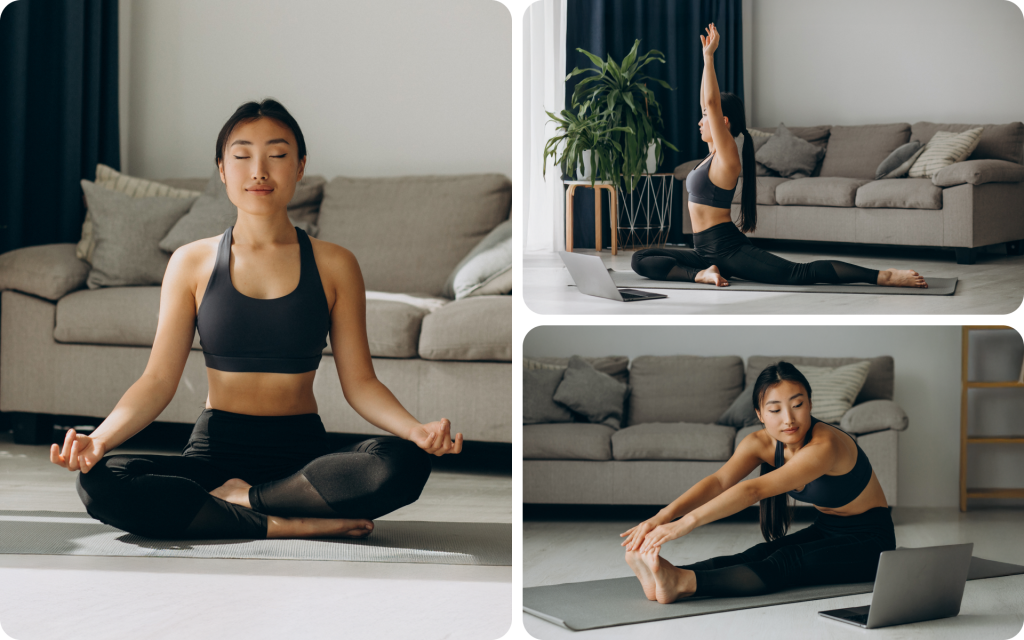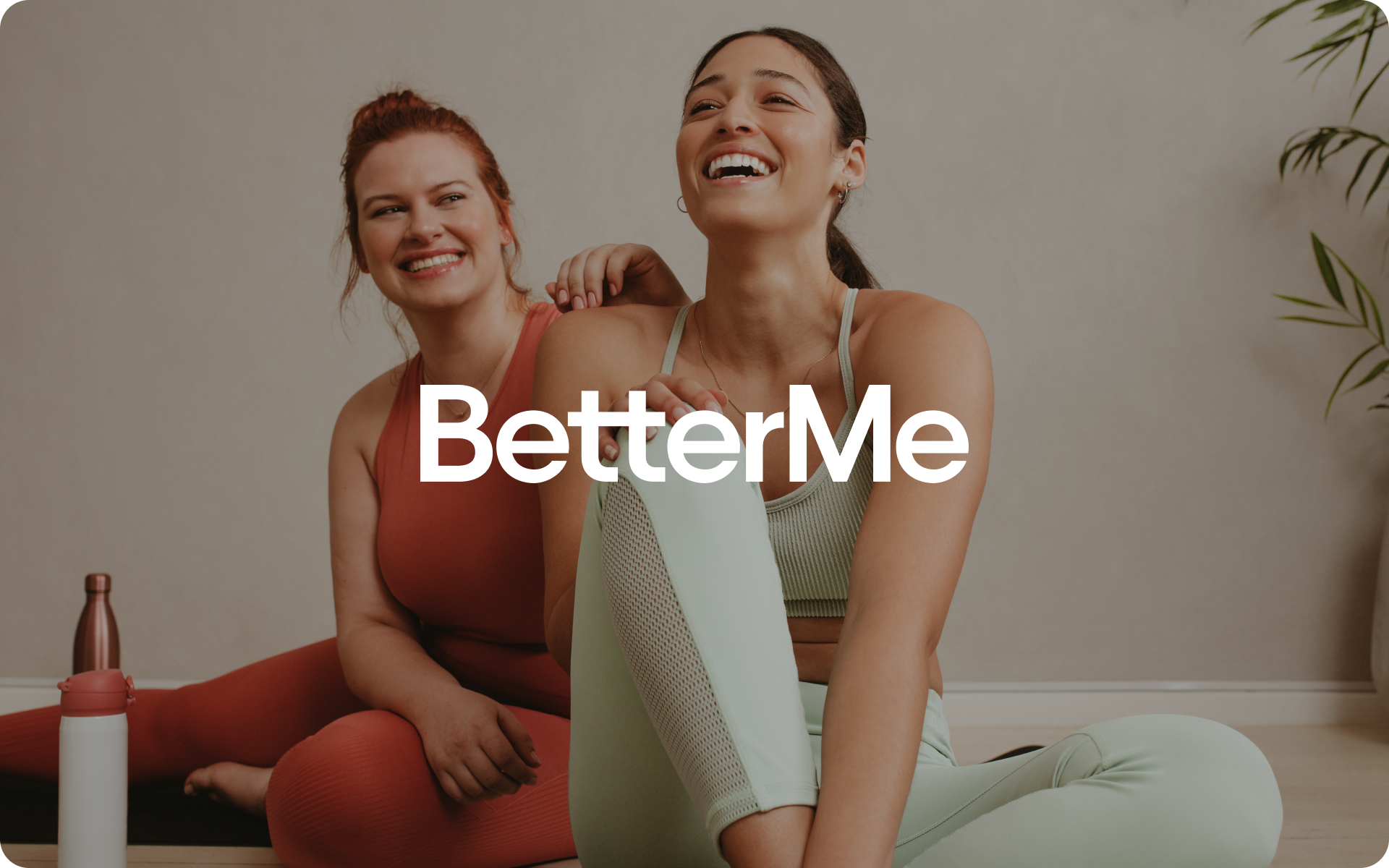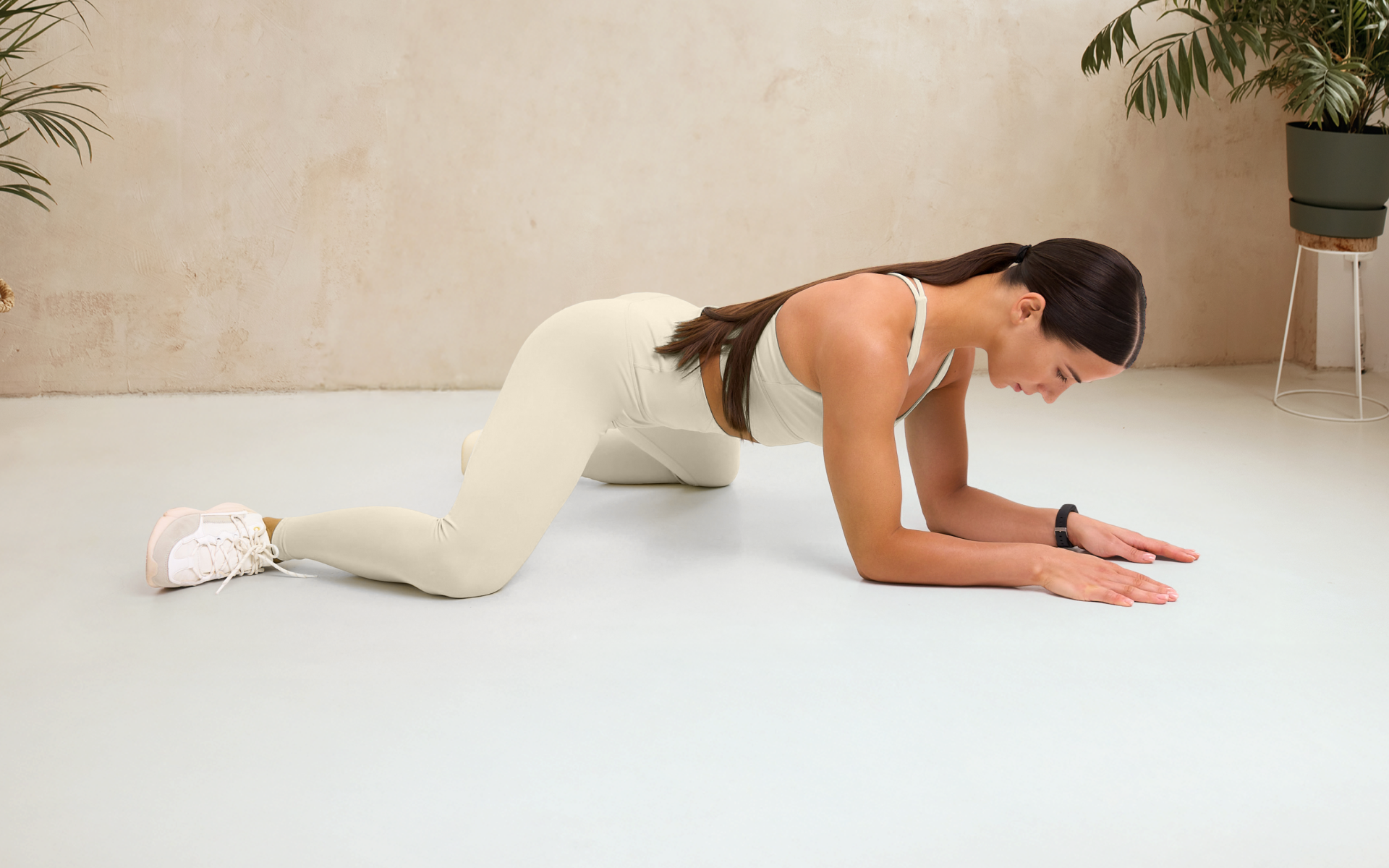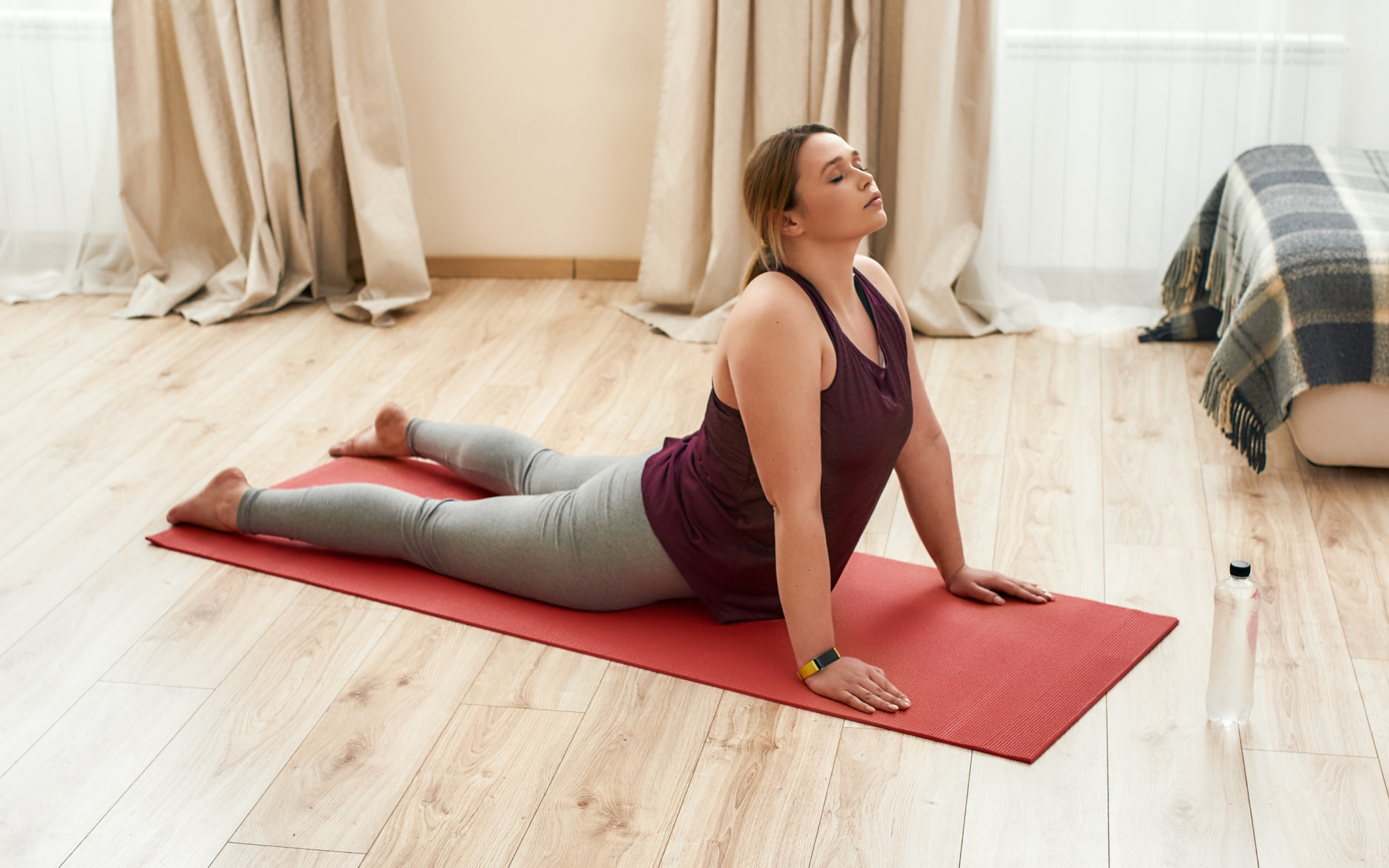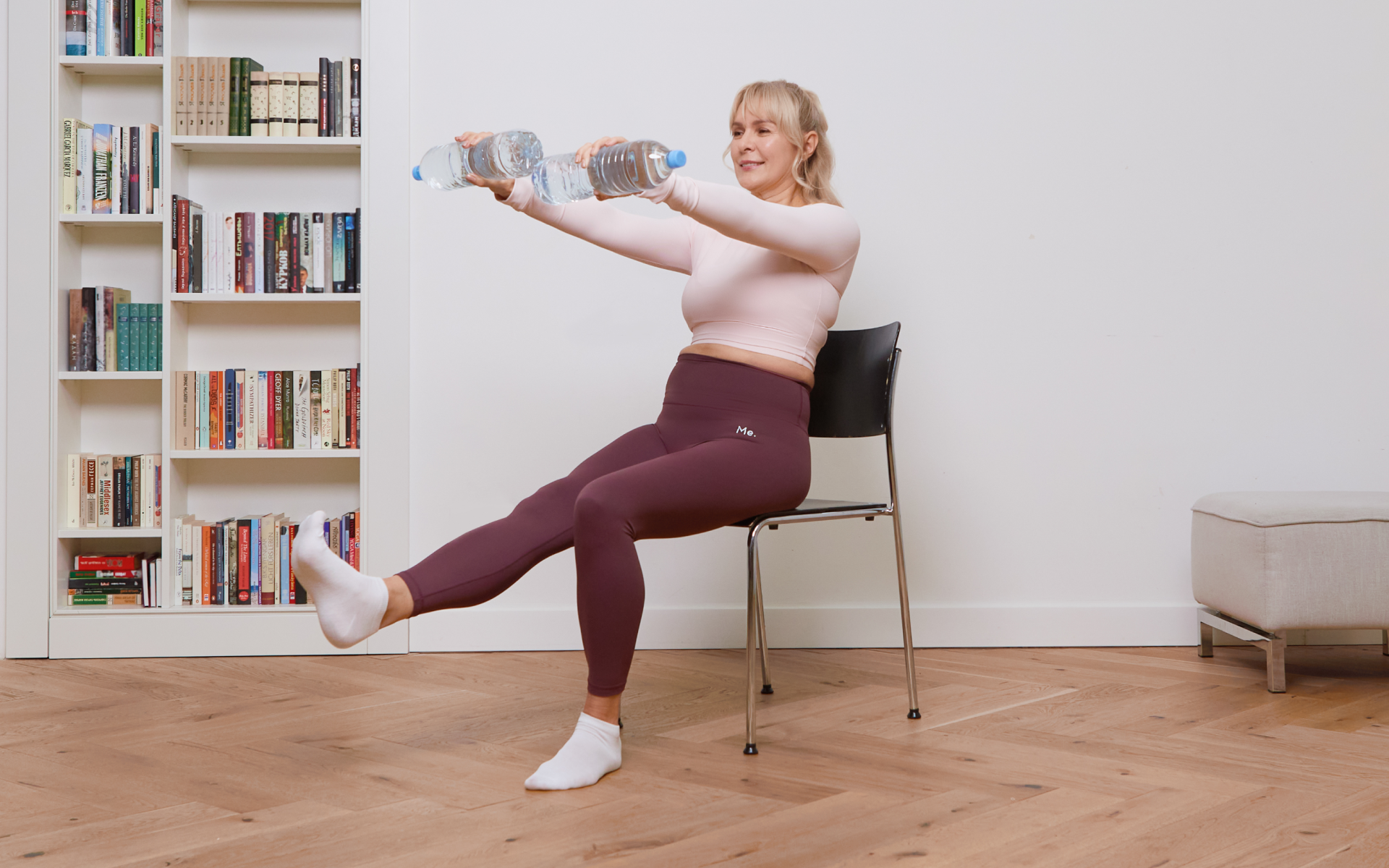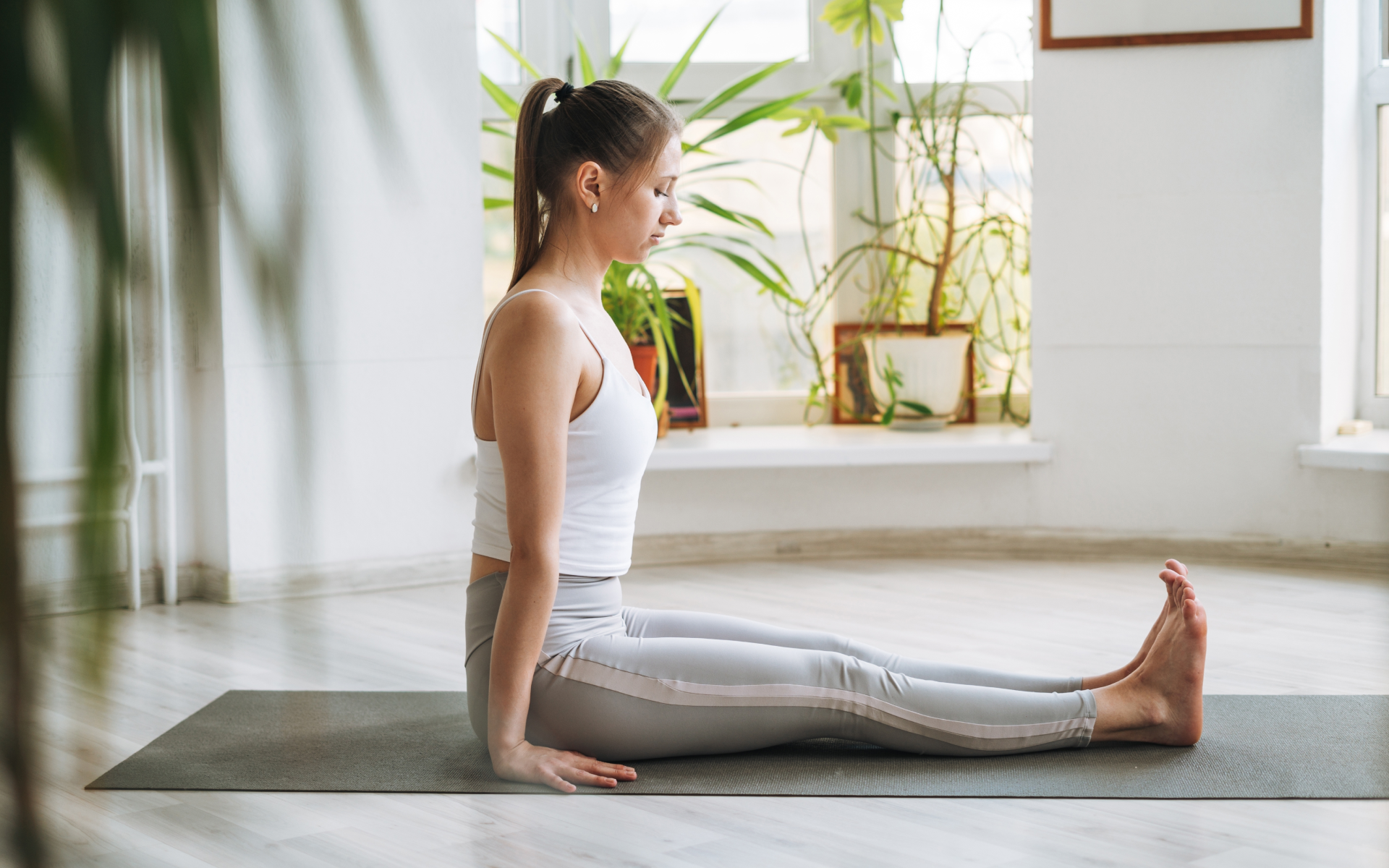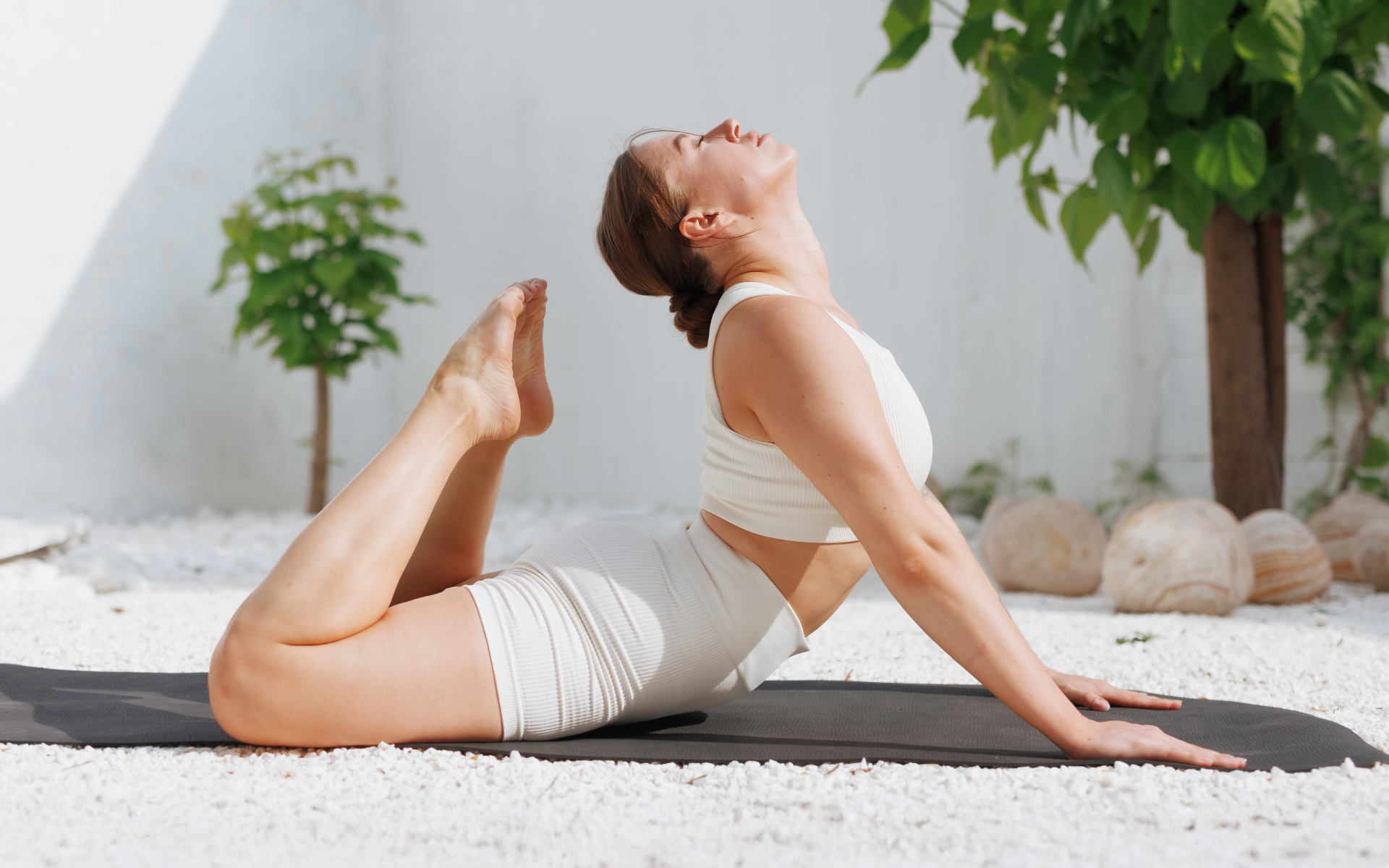As somatic yoga gains attention due to its powerful mind-body benefits, one of its biggest strengths is how easily it can be adapted to different body types and ability levels.
Somatic yoga provides a supportive way to reconnect with your body without pressure to perform, look a certain way, or achieve fitness results. The focus is on cultivating internal awareness – tuning into how your body feels as you move, rather than striving for strength, flexibility, or other external goals.
Always check with your physician before you start any new practice. Once you’re cleared, you can safely explore it at home, using modified poses, props, and other variations for added support.
This article will explore what exactly somatic yoga for plus-size beginners looks like and some practical tips to help you get started with confidence.
What Is Somatic Yoga for Plus-Size Beginners?
Somatic yoga is a gentle, mindful style of movement that uses traditional yoga poses, but with an internal focus on how your body feels rather than how it looks (1, 2, 3).
The purpose of plus-size yoga isn’t about changing yoga itself – it’s about adapting the practice to meet your body’s needs. With supportive modifications and a focus on inner experience rather than performance, somatic yoga can be a welcoming entry point for beginners with larger bodies to explore movement enjoyably (4).
As the goal is internal exploration over external results, this approach naturally allows for adaptability in movement, pace, and form. This makes it particularly ideal for anyone who’s felt out of place or excluded from traditional fitness spaces.
How Somatic Yoga Differs from Traditional Yoga
While traditional yoga has a mind-body component, many modern styles tend to emphasize flexibility, alignment, and holding specific poses (5). Somatic yoga shifts the focus away from achieving perfect form and instead encourages you to notice how your body feels as you move (2).
An essential part of this practice is developing body awareness to help you move with greater intention, which is often explored in three key areas (6):
- Interoceptive awareness: Tuning into internal sensations such as breath, muscle tension, digestion, or heart rate
- Exteroceptive awareness: Noticing external stimuli and surroundings, such as the feeling of the floor beneath you or noises in the background
- Proprioceptive awareness: Understanding how your body is positioned and moves in space
Reasons why BetterMe is a safe bet: a wide range of calorie-blasting workouts, finger-licking recipes, 24/7 support, challenges that’ll keep you on your best game, and that just scratches the surface! Start using our app and watch the magic happen.
Principles of Adaptability
One of the biggest strengths of somatic yoga is how inclusive and adaptable it is. Each movement can be adjusted to fit your comfort level, which gives you full permission to honor your body’s needs without pressure or comparison.
Here are some core principles that help make somatic yoga user-friendly for people of all shapes, sizes, and experience levels:
- Poses are easy to modify to suit your comfort and mobility
- Prioritizes internal awareness over shape, form, or physical outcomes
- Use of props, such as yoga blocks or a chair, can be used for added support
- Self-compassion is encouraged over self-criticism, comparison, or judgment
- Self-paced approach with no expectation to keep up or hold poses for too long
Read more: Somatic Yoga Moves Explained: Benefits, Examples, and How to Begin
Is Somatic Yoga Good for Plus-Size Beginners?
Yes, yoga can be a friendly, empowering practice for plus-size beginners when it’s approached with the right mindset. That being said, it’s still wise to check in with your healthcare provider beforehand for personalized advice and guidance, particularly if you’re managing any medical or mental health concerns.
After you get the go-ahead from your healthcare provider, you can explore somatic yoga at a pace that feels right for you. The next sections will explain more about how somatic yoga can support plus-size beginners and why it can be a beneficial place to start.
Benefits of Somatic Yoga for Plus-Size Beginners
Somatic yoga can offer a wide range of wellness benefits for people in plus-size bodies. While everyone’s experience is different, many find that somatic yoga can support overall well-being in the following ways:
- Mind-body awareness: Strengthens your connection to internal sensations to help you better understand and respond to your body’s needs (7).
- Improved mobility: Uses gentle movement to reduce tension and stiffness, helping you feel more in control of your body (7, 9).
- Everyday stress reduction: Helps regulate emotional responses by calming you during mindful movement (8).
- Deeper relaxation: Encourages you to slow down, breathe deeply, and get in touch with yourself in the present moment (3, 9).
Common Concerns and Misconceptions
It’s natural to feel hesitant about starting somatic yoga in a larger body, particularly due to the stereotypes that often surround fitness spaces. Let’s unpack a few widespread myths:
- “Yoga is only for thin, flexible people.” Yoga poses can be easily modified to any fitness level, which makes it user-friendly and enjoyable for people of any size.
- “I won’t be able to keep up.” Somatic yoga releases this pressure to perform by focusing on slow, intuitive movement at your own pace.
- “Yoga isn’t effective without advanced poses.” Progress isn’t defined by the difficulty of the pose – even gentle somatic movement can support your goals without forcing your body into uncomfortable positions.
By letting go of these misconceptions, you create space to approach plus-size yoga with confidence, curiosity, and self-compassion – without feeling like your body needs to change before you start. If you find it difficult to release these beliefs, you should consider speaking with a body-positive therapist who can help you process them and build a deeper relationship with movement and self-image.
What Are Examples of Somatic Exercises?
Almost any somatic exercise, including those that are found in somatic yoga, can be adapted to suit plus-size beginners. The key is to start simple, then gradually extend your sessions or try more advanced poses when your body feels ready.
Below are three beginner-friendly somatic yoga exercises that are easy to modify and can be practiced at home with minimal equipment.
Modified Cat-Cow Pose
Cat-cow is a classic yoga sequence used to warm up the spine, and it can be easily adapted for plus-size bodies (10). Here’s how to practice it somatically:
- Begin on your hands and knees in a tabletop position, aligning your wrists under your shoulders and your knees under your hips.
- If this position is uncomfortable, you can choose to elevate your hands on blocks, a chair, or another surface to lessen the pressure.
- Inhale slowly as you lower your belly toward the floor and lift your chest and tailbone upward (cow pose), only going as far as feels comfortable.
- Pause and notice what sensations arise without judgment (warmth? tightness?).
- Exhale slowly as you gently round your spine, tucking your chin and tailbone inward (cat pose), allowing your head to relax fully.
- Continue moving slowly between the two poses, syncing your breath with each movement.
Tip: Don’t worry about form or trying to get a deep arch, and instead focus on how the movement feels from the inside out. Ask yourself: What do I feel internally? What areas feel tight, relaxed, or resistant?
Whether you’re a workout beast or just a beginner making your first foray into the world of fitness and dieting – BetterMe has a lot to offer to both newbies and experts! Install the app and experience the versatility first-hand!
Seated Forward Bend
The seated forward bend offers a deeper stretch, and it’s particularly user-friendly when using a yoga strap or towel for support (11). Here’s how to do it somatically:
- Sit on the floor with your legs extended, bending your knees slightly if that’s more comfortable.
- Inhale slowly as you extend your arms toward the ceiling, lengthening your spine.
- Exhale as you gently hinge forward at the hips (not the waist), only going as far as feels natural.
- If necessary, try looping a yoga strap, band, or towel around your feet and holding the ends lightly for support.
- Once in this position, pause and breathe deeply, taking a moment to notice how your body responds to this stretch.
- With each inhale, focus on lengthening your spine, and with each exhale, focus on softening deeper into this position.
- After a few minutes, gently come back to the seated position.
Tip: The goal here isn’t to reach your toes or increase flexibility, it’s about tuning into your body’s sensations with curiosity and recognizing its needs in the moment.
Child’s Pose
Child’s pose is considered a soothing rest or gentle position in yoga, which makes it suitable for any somatic practice (12). Here’s how to do it somatically:
- Kneel on the floor with your knees slightly apart and your toes together.
- If needed, place a pillow, cushion, or folded blanket under your knees for support.
- Sit back toward your heels, allowing your posture to shift naturally.
- Slowly fold forward, letting your forehead rest on the floor, a yoga block, your hands, a pillow, or another supportive surface.
- Stretch your arms forward or rest them next to your body, whichever feels best.
- Take slow, deep breaths in this position, allowing your back and belly to expand naturally with each inhale.
- With each exhale, focus on softening any areas of tension or tightness.
- Stay here for as long as it feels good, then slowly walk your hands back and rise to a kneeling position to end the exercise.
Tip: Comfort is the main priority in all somatic yoga poses, but particularly this one. Let your body settle into a natural position rather than pushing toward a certain shape.
Read more: The Power of Somatic Exercises for Promoting Calmness: A Comprehensive Guide
What Exercises Should Plus-Size Beginners Avoid?
While most yoga poses can be adapted for all body types, certain movements may be uncomfortable or unsafe when they’re performed without the proper support.
Rather than avoiding yoga altogether, it’s better to limit specific variations and use modifications that protect your body and honor your current mobility level. If you’re unsure where to start or what’s right for you, consider booking a session with a certified yoga therapist or consulting your healthcare provider to get personalized guidance. Here are a few movements to approach with caution (13):
- Full inversions without support (such as headstands or shoulder stands) can place excessive pressure and strain on the body.
- Deep stretches without props can potentially cause discomfort and strain.
- Poses that overload the knees or wrists (such as full planks) without the use of blocks, cushions, or other modifications.
- Fast-paced flows or forced movements go against the somatic principle of moving slowly and mindfully at your own pace.
If you’re in doubt, choose comfort over intensity. Your body will benefit more from steady progress than from pushing too far, too fast.
There’s no set schedule that you should adhere to with somatic yoga. The best routine is one you can stick to without stress, guilt, or pressure. If you’re a beginner, try 5-10-minute sessions a few times a week, and then build your way up from there. You can also experiment with different times of day. Some people enjoy morning sessions to set a calm tone for the day, while others prefer practicing in the evening to unwind and relax before bed (14). Try both and notice when your body feels the most receptive. There’s no universal timeline, as everyone’s journey is personal and unique. Some may notice benefits right away, while for others, changes may unfold more gradually. Some people may find somatic yoga highly beneficial for their mental wellness, while others may find they are becoming more flexible as time goes on. What matters most is having patience and self-compassion, rather than judging yourself for not progressing “fast enough”. This is where partnering with a healthcare provider can be particularly helpful – they can track subtle changes you might miss, provide personalized guidance, and help set realistic goals based on your unique health needs. While somatic yoga isn’t designed primarily for weight loss, its focus on mindful movement can indirectly support overall well-being. By reducing everyday stress and fostering a deeper relationship with physical activity, somatic yoga may naturally contribute to sustainable weight changes over time (15). The goal of somatic yoga isn’t to “burn calories”, but to reconnect with your body’s sensations, including hunger, fullness, and movement preferences, rather than following rigid rules (16). In this way, weight loss may occur as a byproduct of improved awareness and self-care, especially when paired with other supportive habits. Dive deeper into the somatic exercises for weight loss with our dedicated article. If your intention includes weight management, somatic yoga can serve as a gentle starting point before moving into more active or longer sessions. For safe and lasting results, combine it with a balanced diet and personalized guidance from your healthcare provider (17). The main goal of somatic yoga isn’t to burn calories, and it shouldn’t be your primary focus. Instead, your focus should be on paying attention to how your body feels during each session, not how it looks or how many calories you’re burning. For a clearer picture, it’s best to discuss calorie goals or weight-related concerns with a healthcare professional who understands your full health history. A “somatic detox” isn’t about flushing toxins from your body, but refers to the process of releasing stored tension or stress through gentle, somatic movement (2). While it’s not a weight-loss method in the traditional sense, it can potentially support healthier habits that benefit your overall well-being. If you’re curious about somatic weight loss, check out our earlier article.Frequently Asked Questions
How many times a week should you do somatic yoga?
How long does it take to see results from somatic yoga?
Can somatic yoga help you lose weight?
How many calories do you burn in somatic yoga?
What is a somatic detox for weight loss?
The Bottom Line
Somatic yoga for plus-size beginners isn’t about perfecting poses, changing your body, or keeping up with anyone else. Instead, it’s about reconnecting with yourself in a way that feels supportive, sustainable, and enjoyable.
Whether you’re testing the waters with a few minutes each day or wanting to dive into a full somatic yoga routine, there’s no “right” way to begin. The best practice is one that feels good in your body today.
Check out the BetterMe app for more insights, tutorials, and resources to help you on your journey to becoming a healthier, happier you.
DISCLAIMER:
This article is intended for general informational purposes only and does not serve to address individual circumstances. It is not a substitute for professional advice or help and should not be relied on for making any kind of decision-making. Any action taken as a direct or indirect result of the information in this article is entirely at your own risk and is your sole responsibility.
BetterMe, its content staff, and its medical advisors accept no responsibility for inaccuracies, errors, misstatements, inconsistencies, or omissions and specifically disclaim any liability, loss or risk, personal, professional or otherwise, which may be incurred as a consequence, directly or indirectly, of the use and/or application of any content.
You should always seek the advice of your physician or other qualified health provider with any questions you may have regarding a medical condition or your specific situation. Never disregard professional medical advice or delay seeking it because of BetterMe content. If you suspect or think you may have a medical emergency, call your doctor.
SOURCES:
- Yoga as a Mind-Body Practice (2020, link.springer.com)
- Mindful Movement: The Evolution of the Somatic Arts and Conscious Action (2016, jstor.org)
- Exploring the therapeutic effects of yoga and its ability to increase quality of life (2011, nih.gov)
- Psychophysiological Adaptations to Yoga Practice in Overweight and Obese Individuals: A Topical Review (2022, nih.gov)
- Yoga bodies, yoga minds: contextualising the health discourses and practices of modern postural yoga (2021, tandfonline.com)
- An Overview of the Bodily Awareness Representation and Interoception: Insights and Progress in the Field of Neurorehabilitation Research (2024, nih.gov)
- Somatic movement intervention among older adults to improve body awareness and spine mobility: A pilot study (2025, sciencedirect.com)
- Reduce stress and the risk of burnout by using yoga techniques. Pilot study (2024, nih.gov)
- Impact of Somatic Yoga and Meditation on Fall Risk, Function, and Quality of Life for Chemotherapy-Induced Peripheral Neuropathy Syndrome in Cancer Survivors (2019, nih.gov)
- Cat/cow pose (2023, mayoclinic.org)
- A Comprehensive Review of Paschimottanasana: Benefits, Variations, and Scientific Evidence (2023, academia.edu)
- Child’s pose (2023, mayoclinic.org)
- Safety and Prevention of Injuries in Yoga (2024, nih.gov)
- Developing Your Daily Practice of Clinical Somatics Exercises (2023, somaticmovementcenter.com)
- Understanding the importance of weight management: a qualitative exploration of lived individual experiences (2024, tandfonline.com)
- Mind−Body Practice and Body Weight Status in a Large Population-Based Sample of Adults (2016, sciencedirect.com)
- Physical Activity and Weight Loss Maintenance (2025, nih.gov)
